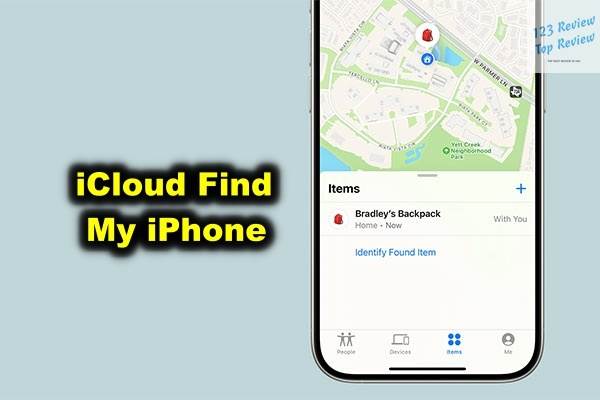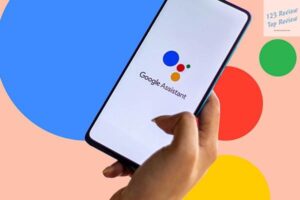In our increasingly digital world, the security and accessibility of our devices are paramount. Apple’s “iCloud Find My iPhone” is an essential feature that helps users locate their lost devices, safeguard personal data, and much more.

In this article, 123 Review provides an in-depth look into setting up, using, and troubleshooting Find My iPhone, ensuring you can always keep track of your device and protect your information.
Setup and Configuration
How to Enable Find My iPhone
Enabling Find My iPhone is the crucial first step in securing your device. This feature must be turned on to locate your iPhone if it goes missing. Here’s how to enable it:
- Open the Settings app: Locate the gear icon on your home screen and tap it to open the Settings app.
- Tap on your Apple ID: This is the first option at the top of the Settings menu and usually displays your name and profile picture.
- Select Find My: Scroll down to find the “Find My” option and tap it.
- Toggle on Find My iPhone: Ensure the switch next to “Find My iPhone” is turned on.
- Enable Send Last Location: Toggle on “Send Last Location” to allow your device to send its last known location to Apple when the battery is critically low.
Linking Your Device to iCloud
Linking your device to iCloud is essential for Find My iPhone to function correctly. Here’s how to link your device:
- Go to Settings: Open the Settings app on your iPhone.
- Tap your Apple ID: At the top of the screen, tap your Apple ID.
- Select iCloud: From the list of options, select iCloud.
- Ensure Find My iPhone is toggled on: Make sure the switch next to “Find My iPhone” is in the on position.
Setting Up Family Sharing for Find My
Family Sharing allows you to share your location with family members, making it easier to find lost devices within your family group. To set up Family Sharing:
- Open Settings: Tap the Settings app.
- Tap your Apple ID: Select your Apple ID at the top of the screen.
- Select Family Sharing: Tap “Family Sharing” to start the setup process.
- Add Family Member: Follow the prompts to invite family members. They will need to accept the invitation.
- Enable Share My Location: Ensure “Share My Location” is enabled so family members can see your device’s location.
Enabling Location Services for Accuracy
Location Services need to be enabled for Find My iPhone to work accurately. To enable Location Services:
- Open Settings: Tap the Settings app.
- Go to Privacy: Scroll down and tap “Privacy.”
- Select Location Services: Tap “Location Services.”
- Toggle on Location Services: Ensure the switch at the top is turned on.
- Set Find My to Always: Scroll down to “Find My” and set it to “While Using the App” or “Always” for the best accuracy.
Using Find My iPhone
Locating Your Device on a Map
When you need to locate your device, you can do so via the Find My app or iCloud.com. Here’s how:
- Open the Find My app: Launch the Find My app on another Apple device.
- Sign in with your Apple ID: Use the same Apple ID that’s linked to your lost device.
- Select your device: Choose the device you want to locate from the list.
- View the location on a map: The app will display your device’s location on a map.
Alternatively, you can use a web browser:
- Visit iCloud.com: Go to iCloud.com.
- Sign in with your Apple ID: Enter your Apple ID and password.
- Click Find iPhone: Select “Find iPhone” from the available options.
- Select your device: Choose your device from the list to view its location on the map.
Playing a Sound to Find Your Device
If your device is nearby but you can’t find it, playing a sound can help:
- Open the Find My app: On another Apple device, open the Find My app.
- Select your device: Choose the device you want to find from the list.
- Tap Play Sound: Your device will emit a loud pinging noise, making it easier to locate.
On iCloud.com:
- Sign in to iCloud.com: Go to iCloud.com and sign in.
- Select Find iPhone: Click on “Find iPhone.”
- Choose your device: Select your device from the list.
- Click Play Sound: The device will start emitting a sound.
Activating Lost Mode
Lost Mode locks your device and tracks its location. Here’s how to activate it:
- Open the Find My app: Use the Find My app on another Apple device.
- Select your device: Choose the lost device from the list.
- Tap Mark As Lost: Follow the prompts to lock your device.
- Display a contact message: You can display a custom message on the lock screen with your contact information.
Using iCloud.com:
- Sign in to iCloud.com: Go to iCloud.com and sign in.
- Click Find iPhone: Select “Find iPhone.”
- Choose your device: Select the lost device from the list.
- Click Mark As Lost: Follow the instructions to lock your device and display a contact message.
Viewing Last Known Location
If your device is offline, Find My iPhone can show its last known location. To view it:
- Open the Find My app: Launch the Find My app on another Apple device.
- Select your device: Choose the offline device from the list.
- View the last known location: The app will display the last known location on the map.
On iCloud.com:
- Sign in to iCloud.com: Go to iCloud.com and sign in.
- Click Find iPhone: Select “Find iPhone.”
- Choose your device: Select the offline device from the list.
- View the last known location: The last known location will be displayed on the map.
Privacy and Security Features
Understanding Activation Lock
Activation Lock is a critical security feature that prevents anyone from using your device if it’s lost or stolen. Here’s how it works:
- Automatic Activation: Activation Lock is automatically enabled when you turn on Find My iPhone.
- Requires Apple ID: To turn off Find My iPhone, erase the device, or reactivate and use the device, your Apple ID and password are required.
- Secures Your Device: This feature ensures that your device cannot be used without your permission.
Protecting Your Data with iCloud Security
iCloud offers robust security measures to protect your data:
- Encryption: All data communication with iCloud is encrypted, ensuring your information is secure.
- Secure Storage: Your data is stored securely on Apple’s servers and is protected by your Apple ID and password.
- Two-Factor Authentication: Enable two-factor authentication for an added layer of security, requiring both your password and a verification code to access your account.
Notifications for Lost Devices
To receive notifications when your lost device is found:
- Open the Find My app: Launch the app on another Apple device.
- Select your device: Choose the lost device from the list.
- Toggle on Notify When Found: Ensure this option is enabled to receive alerts when your device is located.
Sharing Your Location with Trusted Contacts
Sharing your location with trusted contacts can enhance security:
- Open Settings: Tap the Settings app on your iPhone.
- Go to Privacy: Select “Privacy.”
- Select Location Services: Tap “Location Services.”
- Enable Share My Location: Toggle on “Share My Location.”
- Add trusted contacts: Choose the contacts you want to share your location with.
Troubleshooting Common Issues
What to Do If Your Device Is Offline
If your device is offline, here’s what you can do:
- Check the Last Known Location: Find My iPhone will show the device’s last known location.
- Enable Notify When Found: Turn on this feature to receive an alert when your device comes online.
- Activate Lost Mode: Use Lost Mode to lock your device and track its location once it’s back online.
Strategies for Recovering a Lost Device
To recover a lost device:
- Use Lost Mode: Lock your device and display a custom message with your contact information.
- Play a Sound: If your device is nearby, play a sound to locate it.
- Report to Local Law Enforcement: Provide them with the serial number of your device, which can be found in your Apple ID account settings.
Adjusting Settings if Find My iPhone Isn’t Working
If Find My iPhone isn’t working properly:
- Check Location Services: Ensure Location Services are enabled and set to “Always” or “While Using the App.”
- Verify Find My iPhone Settings: Make sure Find My iPhone is enabled in your device settings.
- Restart Your Device: Sometimes, a simple restart can resolve issues.
Contacting Apple Support for Assistance
If you’re still having trouble, contact Apple Support:
- Visit Apple’s Support Website: Go to Apple Support.
- Select Your Device: Choose the device you need help with.
- Follow the Prompts: Get in touch with Apple Support for further assistance.
Conclusion
Find My iPhone is a powerful tool that enhances the security of your Apple devices. By following this guide, you can ensure that your devices are set up correctly, know how to use the features effectively, and are prepared to handle any issues that may arise. Stay secure and keep track of your valuable devices with Find My iPhone.





